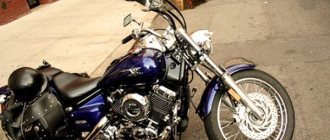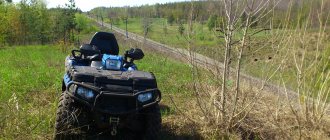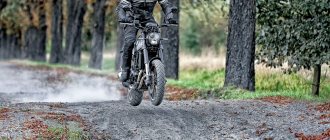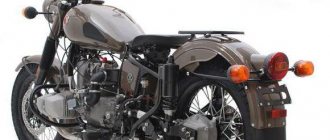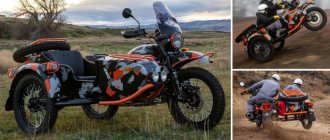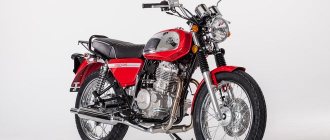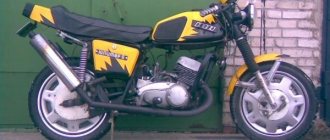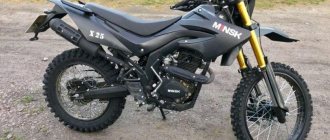Technical specification tables for a motorcycle chassis often indicate parameters such as rake And trail, But what does it mean?
Rake
Rake - represents the angle between two imaginary lines. The first is vertical and extends to the ground, passing through the center of the motorcycle's front wheel. The second line runs through the center of the head tube and relates to the characteristics of the frame rather than the fork. The rake is often mistaken for the fork angle, although in practice they may not coincide. Choppers have rake - their forks are very extended forward. Sports motorcycles have rake - their forks are closer to the vertical. A typical sports bike might have a rake of 25 degrees, while a chopper will have closer to 45 degrees. Touring motorcycles tend to have an angle of 29, while cruisers are around 32.
A larger rake does two things: firstly, it increases the wheelbase, and secondly, it increases the trail of the motorcycle.
MY MOTORCYCLE
When you make some kind of custom, or simply make small changes to the design of the motorcycle, especially when it comes to the frame and other elements, then these changes will certainly affect the behavior of your bike on the road in the future! Why does this happen?, because we fit into the “motorcycle geometry” that the engineers created at the factory and it affects! Therefore, when building (remaking) an iron horse, it is imperative to take this fact into account.
So let's talk about “motorcycle geometry”:
The steering column angle (α) is one of the parameters that determines the geometry of the motorcycle. This is the name given to a group of geometric quantities that directly affect the stability and controllability of the machine. This angle is measured between the vertical and the axis passing through the centers of the steering column bearings. In English literature it is called “rake angle”. Sometimes this angle is measured not from the vertical, but from the horizontal, the so-called “castor”.
Of course, a castor of 66 degrees is equal to a tilt angle (90 - 66 =) 24 degrees. Another value is directly related to the angle of the steering column - reach (c), or “trail” in English. It is equal to the distance between the point of contact of the front tire with the road and the imaginary point of intersection of the steering column axis with the road.
To understand how these quantities affect the behavior of a motorcycle, consider a special case: the front wheel turns to the left under the influence of external forces (driver efforts, gust of wind, road unevenness). Since the intersection points of the steering column axis with the road and the contact of the tire with the road do not coincide, drift of the front tire occurs, and its magnitude is directly proportional to the angle of rotation of the wheel and the offset. This drift, in turn, causes the appearance of a friction force (F), which tends to return the wheel to its previous position.
Thus, the greater the reach, the better the stability of the motorcycle when driving in a straight line. But at the same time, with an increased reach, it is more difficult to take the car out of straight-line motion. With a low reach, the motorcycle becomes easy to control, but extremely sensitive to attempts to lead it off the straight path.
Not only the fork offset affects the handling of the motorcycle, but also its base (L) . This is a value equal to the distance between the axles of the wheels (in our case, the distance between the points of contact of the wheels with the road is more important, but these values are practically the same). , the stability coefficient (R) is usually used
For classic motorcycles, the stability coefficient is usually 6.3-7.0%. Steadfast cruisers are famous for their large values - over 7%, and for nimble sportbikes it is within 5%. For racing motorcycles it is less than 6%, and “dummies” should not ride such machines. The values of the geometric parameters of some characteristic representatives of various classes of motorcycles are given in the table.
Some (already old) sportbikes (Ducaii 996 and Ducaii 748, Bimota SB8) provide adjustments to the angle of the steering column and, accordingly, the reach due to the fact that the steering column bearings are installed in eccentric cages. For example, on the Ducati 996, the angle of inclination varies from 23.5 to 24.5 degrees, and the reach is up to 97 mm. The same goal can be achieved by adjusting the rear suspension: the higher the rear of the motorcycle is raised, the smaller the angle of the steering column and, accordingly, the reach. The same effect can be achieved by lowering the traverses along the pipes of the telescopic fork.
Experienced motorcycle racers use the front brake to increase the agility of the motorcycle. Here's how to perform this trick: Enter a turn and, by braking, achieve “sagging” of the front fork. This reduces the angle of the steering column and the reach - therefore, it makes it easier for you to control the motorcycle...
Fork angle
The fork angle is the angle between the vertical line drawn through the front wheel mounting axis and the center line of the fork leg.
When riding a motorcycle, braking and suspension travel will also significantly change the rake and trail . For example, if you brake hard, the suspension will compress and reduce rake and trail .
Comparing rake and trail for different motorcycles can give you some idea of how they handle, even if you've never ridden one.
To achieve stability at speed, balance and light steering, the chassis incorporates a compromise between rack and trail . For example, a very large rake provides excellent stability at high speed, but is not well suited for normal use. To maintain good stability and proper handling, the rake should be in the normal range (approximately 22 to 32).
Trail Braking
A concept that is known on the track, but used by everyone, from fragile beginner girls to rugged bearded bikers. But only professional racers always remember about it and practice this phenomenon consciously.
Have you ever noticed that when you apply the front brake, or when you perhaps stand on the pegs and lean on the handlebars, at such moments the handling of the motorcycle changes? I'm not talking about balance and not about the horror in your eyes from the clamped brake and wheel lock when you are trying with all your might to cope with the situation.
When braking or other load is applied to the front of the motorcycle, the front fork obviously sags. The meaning of the technique is CONTROLLED braking when maneuvering in a turn. As the fork compressed, its angle changed. The continuation point of the fork has approached the contact patch, therefore Trail... What is he? That's right, it became smaller. It is easier for the motorcycle to enter the turn, but do not forget that you are moving and braking, and even in a turn! Professionals have been honing this skill for a long time. City motorcyclists commit such control methods on an unconscious level, without realizing that they are doing some kind of Trail Braking.
Moreover, your goal is not to stupidly press the lever. You control your speed and trajectory by squeezing the front brake, from start to finish of the maneuver. In the city, this is necessary when the situation tends to stalemate, the hair on your head stands on end, and the counter for the correct action inexorably rolls down to zero, because someone decided to pass the same turn in front of you or did not give way. The reason could be any. The point is that you smoothly adjust your speed with the brake, monitor the angle of inclination and the radius of the turn, and when the peak of the turn has been passed, you also smoothly release the brake so that the motorcycle does not buck, but calmly levels out due to the speed.
Trail Braking requires the rider to have a thorough understanding of the process, nerves of steel and trust in both his own mind and the capabilities of the motorcycle. Any unnecessary body movements, sudden bursts of gas or squeezing the brake more than necessary and you will already fly out of the turn.
Motorcycle - what is it? Types, descriptions, photos of motorcycles
We all saw the motorcycle. We also know what a vehicle is, today we will look in detail at the basics of terms in this category, and also get acquainted with the main classes of “bikes”.
General information
First, let's formulate a general definition. A motorcycle is a wheeled vehicle (two-wheeled, less often three-wheeled). The “heart” of transport is the engine. Most often, a gasoline internal combustion engine is installed, but there are also rare options where an electric motor or pneumatic motor is installed as the power unit, and there are also rare examples of motorcycles with diesel engines.
Top 5 motorcycles for touring with an engine capacity of more than a liter
Not all city dwellers prefer road or sports motorcycles. Some people like to travel by bike. Let most of your time be devoted to work, but riding a motorcycle to places where trains do not go and planes do not fly is also a way of life. There is now a fairly large selection of motorcycles for tourism, although some manage to travel long distances on cruisers - on smooth federal roads.
But traveling on smooth roads can be boring! For those who do not recognize straight and level paths, there are motorcycles that have no fear of forests, mountains and fords.
So, we have collected for you modern, proven motorcycles with an engine capacity of more than a liter. Why more than a “liter”? Because in this segment, what’s not a bike is a legend! In addition, many experienced travelers, fans of Dakar-type races, are looking for models like those of professional racers of such large and complex routes in order to show their “class” on their own.
Socioforum - free online training
Courses, trainings, tests, consultations. Relationships, dating, diaries, games. Psychology and socionics
- List of forums ‹ Communication ‹ Conversations about life ‹ Auto
- Change font size
- print version
- FAQ
- News
- Medals
- Photo gallery
- Registration
- Entrance
Is 125cc enough for a motorcycle?
- Reply with a quote
Is 125cc enough for a motorcycle?
Vadya Rotor » Sun Mar 01, 2009 3:21 pm
Let's leave aside the heavy bikes with driveshaft drive and all that. Let's talk about healthy minimalism. Personally, a 125cc engine is quite enough for me in a light motorcycle. If it is 4-stroke, then it is quite capable of 15 hp, if it is 2-stroke, then generally 25. And Peugeot scooters had a 125 cc engine even with a mechanical supercharger and produced 20 hp. In my opinion, there are quite acceptable offers on the motorcycle market with 125 cc engines, including sports ones (Aprilia, for example).
The minimum for me is 80 cubes; I don’t look at a model with a volume of 50 as a potential purchase. I need a two-wheeled vehicle to travel 105-125 km/h, I don’t need more (it’s unsafe), but less than a hundred is not serious. And a motorcycle weight that would be comfortable for me would be no more than 100 kg, or at least not much more.
- Reply with a quote
Is 125cc enough for a motorcycle?
Vadya Rotor » Sun Mar 01, 2009 3:22 pm
Yamaha YBR 125 looks like a fighter. A teenager's dream. But older people don’t like 125cc cars because they’re skinny. Of course, “To drive at a speed of 120, you must still have a reserve of at least 30 km/h, so that if something happens you can accelerate sharply (when you don’t have time to complete overtaking and you need to accelerate sharply, or someone changes lanes in front of you)”
On the other hand, 50 cc is normal for a two-seater: My cousin had several 50 cc mopeds, the last one (which he rides now) can do 60 km/h in a straight line or about 70 (if downhill). Riding it uphill with two people is quite possible; it goes up a steep hill slowly - it gets on the nerves of some, but those who are patient like me don’t pay attention to it. But the moped is light, two people can carry it; If it ends up somewhere (in a hole or somewhere else), you can pull it out yourself. Practical.
In general, I like to coast downhill, with the engine turned off, when only the tires are noisy.
- Reply with a quote
Is 125cc enough for a motorcycle?
Barmental » Sun Mar 01, 2009 4:31 pm
Vadya Rotor, you are an esthete - roll downhill!
But it depends on what you need a motorcycle for. If you go to work around the city every day, then 125 cubes is enough. If you anneal on a weekend, then 1200 is better, since 650 will not be enough.
Z.Y. With us, up to 125 cubes can be controlled without a license. Therefore, I would take it with this volume.
- Reply with a quote
Is 125cc enough for a motorcycle?
Vadya Rotor » Mon Mar 02, 2009 2:40 pm
IMHO, 1200 cc for a motorcycle - with proper boost, it’s enough to fly into space
And I like to coast both in a car and on a bicycle, I especially like to overtake someone while riding this way. Riding like this really calms your nerves.
- Reply with a quote
Is 125cc enough for a motorcycle?
Barmental » Mon Mar 02, 2009 2:49 pm
Yeah, this is closer to nature or something. Probably like eating with your hands.
Well, a weekend bike should take you into space. Otherwise, adrenaline deficiency will not allow you to relax from everyday work.
- Reply with a quote
Is 125cc enough for a motorcycle?
Vadya Rotor » Mon Mar 02, 2009 2:59 pm
Many people need 1.2 liters to relax on the weekend. but not the engine size, but some drink
But it’s not always possible to cope with a motorcycle that has so much power. And all the show-off guys who buy 600 cc and 1000 cc road bikes with a space-age exterior are buying a machine that doesn’t match their riding skills. Considering that motorcycles are the most dangerous form of transport, these people can simply be called suicide bombers.
By the way, eating with your hands better conveys the energy of food, and various intermediaries (cutlery) do not contribute to this
- Reply with a quote
Is 125cc enough for a motorcycle?
Barmental » Mon Mar 02, 2009 4:07 pm
